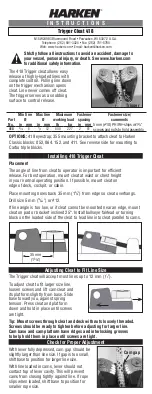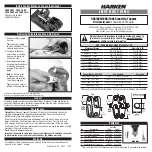
Calibration
Periodic System Span Check
Thermo Fisher Scientific
Omni FTIR Multi Gas CEMS Instruction Manual
4-3
Following a system zero check, a system span check is scheduled to
proceed. Similarly, the system span check is controlled by the operator via
Thermo Modbus Controller (check span) or PLC. By triggering the system
span check solenoid valve, a sufficient span gas flow (>6 LPM) out of the
corresponding gas cylinder is introduced into the sample probe via the
heated umbilical (same heated line as system zero check), right before the
probe primary filter. The deviations in system span drift and/or precision of
the measuring system can be detected, recorded either by system computer
or data logger. Adjustments of the system span value by the operator, or
maintenance of the measuring system (e.g. by the supplier) may be
necessary due to the results of the evaluation. The duration of the system
span check is determined by the operator.
Before performing a system span check, make sure that the gas cylinder is
already connected to the labeled tubing line, following the installation
procedure. Similar to the system zero check procedure, make the necessary
flow rate adjustments to ensure sufficient flow rate (>6 LPM). The
corresponding rotameter for span gas flow rate is right next to system zero
rotameter on the pneumatic control panel shown in
Figure 4–1
.
The system has an option for the operator to perform system dynamic
spiking by triggering the system dynamic solenoid valve (Check Spike)
using Thermo Modbus Controller. To perform the system dynamic
spiking, sampling flow rate should first be measured using a flow meter at
the inlet of the heated sample line. Sample flow rate can be set by adjusting
the eductor pump pressure. The pressure gauge and adjusting knob of the
eductor pump are located on the pneumatic panel (
Figure 4–1
). Spiking
flow rate is set by adjusting the rotameter for a recommended 10 to 1
dilution ratio. For instance, a flow rate of 500 sccm is set for spiking gas,
with respect to the sampling flow rate of 5000 sccm. Alternatively, a
dilution factor can be determined by monitoring tracer SF6 concentration
if a tracer mixed gas cylinder is used for the testing. SF6 concentration is
monitored and saved in “con” file (C:\cons), along with all other gases. The
user can choose to output the SF6 concentration to the data logger via the
system analog output (4-20 mA) terminal.
The external audit gas procedure is similar to the regular system zero, span
and spiking procedures as described above. The only difference is that the
system operator needs to swap the span gas cylinder with the audit gas
source (dry gas cylinder or wet/hot HovaCal output).
Periodic System
Span Check
System Dynamic
Spiking
External Audit
Gas Procedure
Summary of Contents for Omni FTIR Multi Gas CEMS
Page 1: ...Omni FTIR Multi Gas CEMS Instruction Manual Part Number 108004 00 11Apr2013...
Page 4: ...Thermo Fisher Scientific WEEE Compliance...
Page 20: ...Figures xvi Omni FTIR Multi Gas CEMS Instruction Manual Thermo Fisher Scientific...
Page 22: ...Tables xviii Omni FTIR Multi Gas CEMS Instruction Manual Thermo Fisher Scientific...
Page 182: ......
Page 206: ......
Page 216: ......
Page 234: ......
















































